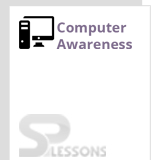 Introduction
Introduction
What is Computer Aptitude?
Computer Aptitude Test is a scientifically validated test designed to measure the aptitude for working with computers. Basically, it measures the ability to solve problems quickly that is essential to truly succeed in every field using computers.
Computers are an integral part of everyday life. Computer aptitude is an important section in many competitive exams primarily related to recruitment. Candidates preparing for banking exams like IBPS PO, SBI PO, and the RBI, must be prepared with Computer Aptitude syllabus.
"A Computer is a device that can be instructed to carry out sequences of arithmetic or logical operations automatically via computer programming". Computers follow a generalized set of operations termed as programs. The programs enable computers to perform an extremely wide range of tasks. Computers are now ubiquitous and are being used in every field of work. Thus, basic knowledge of computers and the ability to operate a computer is now crucial for all job aspirants.
Computer Awareness, also known as Computer Aptitude is one of the prominent sections in various recruitment related competitive exams in India. SBI PO Mains Computer Aptitude Practice Set 8 lists some of the important questions for the preparation of Computer Awareness module. The most significant topics to be learnt for Computer Awareness module are as follows:
- History of Computers
- Computer Fundamentals
- Parts of a Computer System
- Data Processing Cycle of a Computer
- Computer Languages
- Input Devices & Output Devices
- Operating Systems
- Database Management Systems
- Microsoft Office
- Keyboard Shortcuts
- File Extensions
- Networking and Internet
- Computer Viruses
- Important Abbreviations
 Quiz
Quiz
Directions (1-5): Computer Fundamentals
1. Which of the following languages is more suited to a structured program?
- A. [latex]\frac{PL}{1}[/latex]
B. FORTRAN
C. BASIC
D. PASCAL
- A. Data transmission
B. Data flow
C. Data capture
D. Data processing
- A. ALU
B. Memory
C. CPU
D. Control unit
- A. Technological advancement
B. Scientific code
C. Object Oriented Programming
D. All of the above
- A. FORTRAN
B. PROLOG
C. C
D. COBOL
Directions (1-5): System Analysis and Design
1. Positive testing is
- A. running the system with line data by the actual user
B. making sure that the new programs do in fact process certain transactions according to Specifications
C. is checking the logic of one or more programs in the candidate system
D. testing changes made in an existing or a new program
- A. describes how data are structured in the data base
B. specifies for the DBMS what is required; the techniques used to process data
C. determine how data must be structured to produce the user's view
D.All of the above
- A. outputs
B. input (transactions)
C. controls
D. All of the above
- A. pilot
B. phased
C. parallel
D. parallel
- A. transposition error
B. transcription error
C. Beta testing error
D. Alpha testing error
Directions (1-5): Operating Systems
1. The part of machine level instruction, which tells the central processor what has to be done, is
- A. Operation code
B. Address
C. Locator
D. Flip-Flop
- A. 8
B. 1
C. 16
D. 0
- A. assembler
B. linking loader
C. cross compiler
D. load and go
- A. program in High level language kept on disk
B. contents of main memory
C. a program in execution
D. a job in secondary memory
- A. preemptive scheduling
B. non preemptive scheduling
C. shortest job first
D. first come first served
Other Articles
 Study Guide
Study Guide
| Competitive Exams - Study Guide | ||
|---|---|---|
| Category | ||
| Quantitative Aptitude | Reasoning Ability | General Awareness |
| Computer Awareness | English Knowledge | Banking Awareness |
| General Science | World of Words | Descriptive Test |
 Exams
Exams
| Competitive Exams - College Entrance Exams | |||
|---|---|---|---|
| Category | Notification | ||
| Diploma | NITC New Delhi | ||
| Click Here For – All India Entrance Exam Notifications | |||
 Daily CA
Daily CA
 Job-Alerts
Job-Alerts
 SP Quiz
SP Quiz
| Competitive Exams - Practice Sets | |
|---|---|
| Category | Quiz |
| English Knowledge | Spotting Errors |
| Quantitative Aptitude | Ratios and Proportions |
| Reasoning Ability | Puzzles |
| Current Affairs | Current Affairs |
 GK
GK
| General Knowledge for Competitive Examinations | |
|---|---|
| Topic | Name of the Article |
| GK - World | World Longest Train Services |
| World News Agencies | |
| GK - India | June 2019 Awards and Honors |
| Padma Awards 2019 | |
| GK - Abbreviations | Science Information Technology Abbreviations |
| Computer Abbreviations | |
| GK - Banking & Insurance | African Countries Capitals Currencies |
| Countries and Central Banks | |
| GK - Science & Technology | Medical Science Discoveries |
| Chemistry Terminology | |



